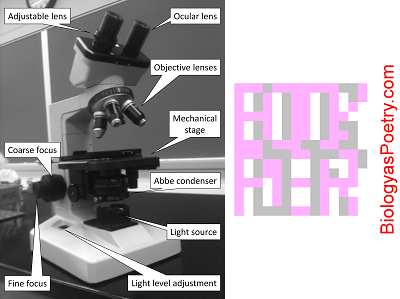∞ generated and posted on 2016.01.14 ∞
Means by which most of the magnification is achieved in a compound microscope, as found directly above the specimen and typically separated into 3 or 4 different magnifications per microscope.
The lens (or lenses) that sit immediately above the specimen (as found on a slide) is called the objective lens (or lenses). The reason for the name is that the specimen is also known as the object and the objective lens is immediately adjacent to the object (rather than immediately adjacent to one's eye or eyes)
The pathway of light is: light source → condenser → iris diaphragm → stage → object/specimen → objective lens → ocular lens → eye or camera. The objective lens will have certain associated magnifications such as 4×, 10×, 40×, and 100×. See also Parfocal.

Figure legend: The objective lenses can be found immediately above the mechanical stage. Note that there are four of them, though here only three are fully visible from this angle, with magnifications of 4×, 10×, 40×, and 100×.
Focusing a microscope typically will involve starting with a lower magnification objective and then working ones way up to a higher magnification. A common mistake is to not follow this sequence, either never bringing magnification up to a high level or, more commonly, to skip attempting to first focus at the lower levels of magnification.
Note that it often is possible to skip the lowest level of magnification. If you are having difficulty focusing your microscope onto the specimen, however, then one thing you might try is to start over at the lowest magnification.